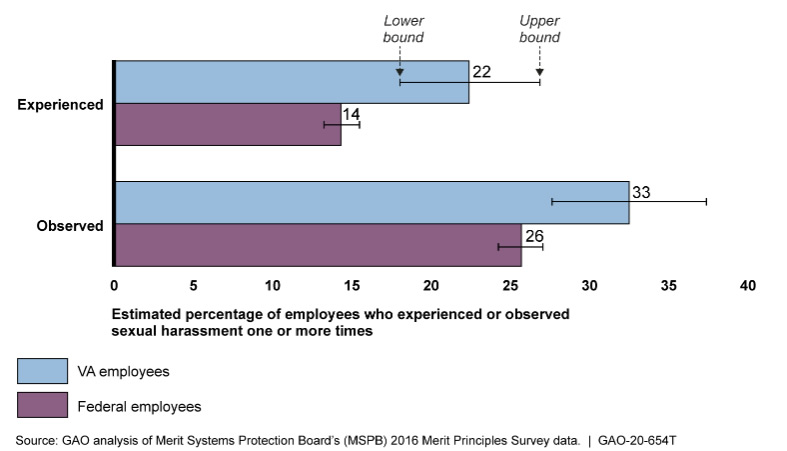WASHINGTON—According to a number of surveys and reports, VA has yet to adequately address the problem of sexual harassment of both employees and patients.
In 2016, a Merit Systems Protection Board survey found that 22% of VA employees experienced workplace sexual harassment, compared with 14% of federal employees overall. And 33% observed sexual harassment, compared with 26% of federal employees overall.

Estimated Percentage of Department of Veterans Affairs (VA) Employees and Federal Employees Overall Who Experienced or Observed Workplace Sexual Harassment from Mid-2014 to Mid-2016
Note: The MSPB survey was most recently administered in 2016 and asked whether respondents had experienced or observed various sexual harassment behaviors one or more times in the preceding 2 years; such behaviors may or may not be unlawful, depending on the circumstances. Estimates shown in this figure have margins of error at the 95 percent confidence level, as shown by bracketed lines on each bar. A more detailed explanation of our methodology is available in our report (see GAO-20-387).
While much of the discussion around sexual harassment at VA has centered on the need for cultural changes at the agency, a Government Accountability Office report released last month points to additional structural problems. Those include a failure by VA to require managers to report all harassment complaints, the inability of the agency to track whether corrective actions are being carried out and conflicts of interest within the department’s Equal Employment Opportunity structure.
Although VA is working to address most of these issues, some of the needed changes will take as long as four years to carry out, a timeframe that both legislators and GAO officials said they find perplexing. There also seems to be a disagreement among agency leaders as to whether sexual harassment is as pervasive in VA as these reports suggest.
VA has three avenues to address sexual harassment complaints. There’s the EEO process, whereby an employee can file a formal complaint and seek damage awards as well as hopefully prevent the recurrence of discriminatory conduct. There’s the Harassment Prevention Program (HPP) operating since 2016 under the Office of Resolution Management (ORM), which requires immediate corrective action that can include disciplinary action against employees. The stated goal of the HPP is to either prevent harassment or bring ongoing harassment to an immediate end. The third avenue is for employees to report sexual harassment to a manager in the hopes the issue can be resolved at the facility level.
While VA has a central repository for EEO and HPP complaints, the department does not currently require its facility managers to report all sexual harassment complaints. Consequently, VA is lacking an accurate snapshot of how big a problem sexual harassment is within the agency.
“There is no requirement—no centralized information system,” Cindy Brown Barnes, GAO’s Education, Workforce and Income Security Team director told legislators at a House VA Subcommittee on Oversight and Investigations hearing last month. “And not just to see the report, but to see if actions have been taken—corrective actions to address sexual harassment.”
According to VA, the agency is developing a centralized case management system and will be requiring all managers to report both harassment complaints and the actions they are taking to address them. However, that will not be in place until September 2021.
Addressing the structural problems within the EEO process will take several years longer, VA officials told legislators. Prior to 2017 all of VA’s EEO program managers reported to the director of their local facility. VA has recognized for years that this creates a real or perceived conflict of interest. Consequently, the agency began realigning its EEO managers in 2017 to report directly to the ORM.
Continue Reading this Article: Lengthy Process
